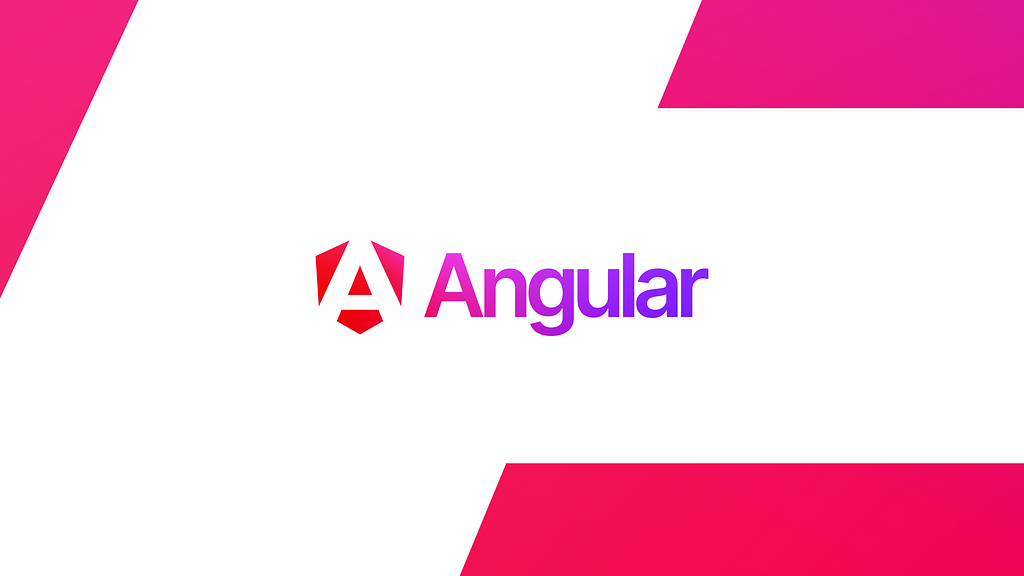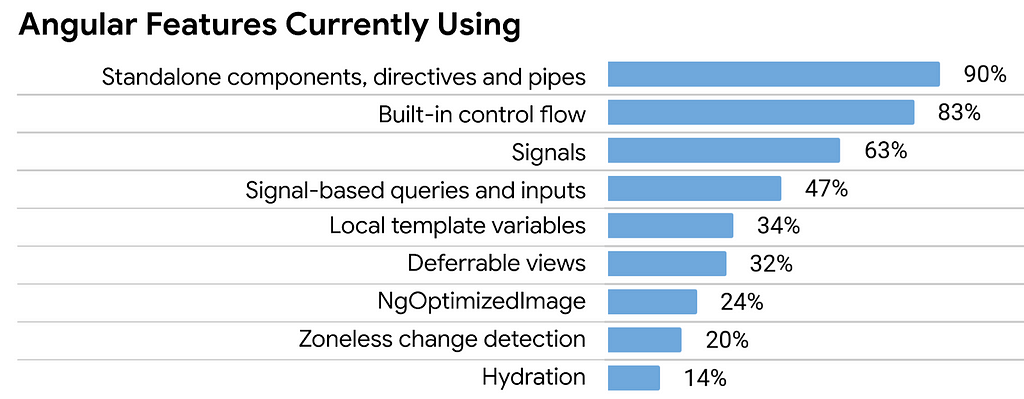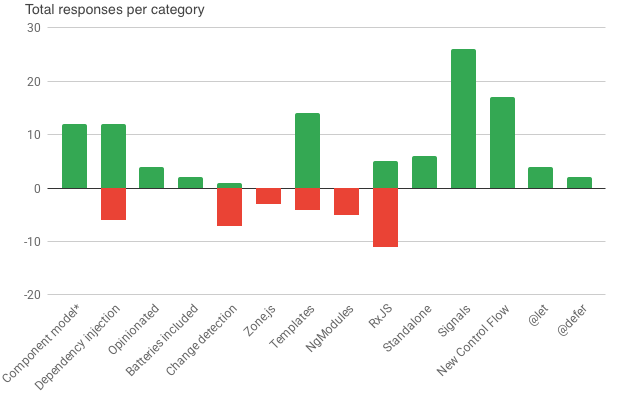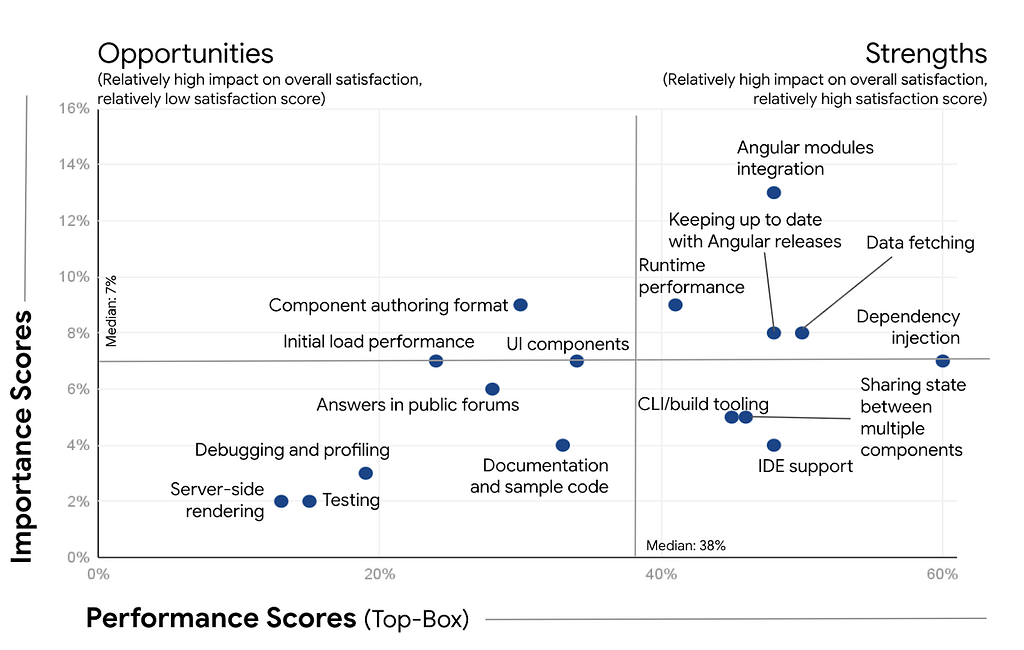This content originally appeared on Angular Blog - Medium and was authored by Minko Gechev
For the past two and a half years, we’ve been laser focused on improving developer experience and performance for all Angular developers. In this post, I’d like to share a brief summary of the high-level process that we’ve been following to achieve this and describe our strategy for 2025.

The tech industry evolves rapidly. For example, it was hard to predict the magnitude of the GenAI revolution until a couple of years ago. This makes it very difficult and impractical to create a fixed plan for Angular that we’ll strictly follow for years ahead. At the same time, it’s important to have a direction and identify metrics that help us know we’re on the right track.
In Angular we achieve this by defining a long-term vision and planning the work on the annual, quarterly, and release basis. Each of these phases operates on a different level of abstraction and is based on the top opportunities ahead of us that we identify based on developers’ needs and industry trends. We also stay flexible to augment these plans quickly though if requirements change or assumptions end up being wrong.
When operating in a large community with millions of developers, it’s easy to introduce proximity bias to the requirement collection process from interactions on social media, on the GitHub issue tracker, conferences, or even from conversations with Googlers. An important tool that helps us validate our assumptions about developers’ needs is our annual developer survey where we receive thousands of responses from our broad community.
Developer survey 2024
For the past couple of years we’ve been sharing the results from our developer survey and today we’ll continue this tradition. This year we kept the survey open until we received close to 10k responses.
79% of developers reported they are using the latest two major versions of Angular, 90% of developers are using standalone components, directives, and pipes, and over 80% of developers are using the built-in control flow:

It’s crucial for us to evolve web apps at all scales to the latest development practices and not leave anyone behind. The results from the survey are validation that our investment in the ng update experience is paying off in supporting developers build modern Angular apps.
In 2024 we also noticed an improvement in the overall developer satisfaction. Close to 90% of developers reported that they are satisfied with the framework. Receiving the results from the survey right before the winter holidays was the best present for us!
We identified that improvements such as standalone components, built-in control flow, local template variable declaration, and deferrable views contributed the most to the satisfaction increase. The chart below is from a targeted survey and shows the positive (in green) and negative (in red) sentiment per feature area in the Angular framework:

After analyzing the open ended answers from the survey we created a chart with the major strengths and opportunities for Angular:

We see how component authoring format continues to exist as a key opportunity to improve developer experience even after the latest changes in template syntax. A recurring pattern we saw was respondents’ dissatisfaction with “double imports” and boilerplate by which they often mean having to import a component in a given JavaScript module followed by component metadata import:
import { Checkbox } from 'component-library';
@Component({
selector: 'my-app',
imports: [Checkbox], // <-- an extra import
template: `<my-checkbox/>`
})
export class App {...}Even though testing didn’t fall in the quadrant with the core opportunities, we consider it critical for creating maintainable, high-quality software and in 2025 we’ll invest in replacing Angular’s default test runner.
Many comments we received are related to better integrations of forms, router, and http with signals and improved forms experience.
Strategy for 2025
Our annual strategy focuses on investing in key areas that help Angular developers succeed. We’re optimizing for a couple of goals:
- Increase of developer satisfaction with enhanced developer experience. We will also be pushing the boundaries of performance and developer experience by continuing to bring innovation to the ecosystem.
- Enable adoption of the latest improvements. This work includes making adoption of new features easier with schematics, increasing the visibility of features within and beyond the Angular community, and more.
Enhancing developer experience
Over the past years Angular has been bringing innovation to the framework and the JavaScript ecosystem as well as making quality of life improvements.
For example, in v19 we shipped incremental hydration that allows you to gradually download only the components that your application needs to handle particular user interactions. As part of this work, we open sourced event dispatch that has been serving billions of users in Google search. Similarly, we released a signals library that’s in the foundation of the current TC39 proposal.
To improve developer experience further, we need to balance the priorities we received from developers with ongoing large initiatives that will be impactful in the long-run. Some notable projects for 2025 are:
- Promote zoneless to developer preview — this project will enable Angular to have a more efficient change detection, improve interoperability (for example, in MFEs), and improve initial load performance.
- Signal forms — looking at GitHub issue tracker, talking to developers, and reading responses in our developer survey we see a lot of opportunities in forms. This includes missing features, scalability, type safety, and unification. To address this, we are prototyping signal-based forms which we’re hoping to be the default recommendation in the long run. Template driven and reactive forms will also benefit from better integration with signals. We’ll continue supporting the existing forms module, making it interoperable with signal forms, while gradually recommending signal forms as the best practice.
- RFC for selectorless components — we’d really like to simplify dependency management in components and we’d also want to include the community in the process without making any rushed decisions. Selectorless will resolve the “double imports” problem and improve the developer experience when creating components. In 2025 we’re planning to run an RFC for selectorless components, gather feedback and prototype a solution.
- Replace Karma — with the deprecation of Karma we’d like to identify a good replacement that we’ll enable as the default recommendation for apps built with Angular. We’ve been exploring Web Test Runner, Jest, and Vitest and as part of this project will evaluate each of these runners and integrate it with the CLI.
That’s just a subset of some of the most impactful work that we’ll focus on in 2025. Together with these critical efforts we’ll continue evolving incremental hydration, Angular’s reactivity story with signals, stabilize effects, route-level render modes, accessibility primitives, and more. For a more holistic view, have a look at our roadmap.
Enable adoption
With the evolution of Angular we’d like to:
- Evolve Angular’s documentation to reflect the latest best practices
- Increase the visibility of features that help web developers meet their goals
- Make it easy to adopt Angular in your existing stack
Having excellent documentation is essential for any product. In v17 we shipped angular.dev which was a step towards improving Angular’s learning journey. We see a plethora of other improvements that will help developers learn about the latest best practices and understand deeply technical concepts.
With the latest improvements we’ve been also seeing growth in the community. Folks new to web development want to start their careers with Angular and developers from other communities want to benefit from some of Angular’s latest features.
We will evolve Angular’s documentation to meet all these use cases.
With the latest releases we’ve been seeing growing excitement about Angular’s new features. Independent content creators from the community have been covering them with videos and YouTubers who have been historically averse to Angular showed appreciation of our recent release. That’s very gratifying and we’re glad that people appreciate Angular’s evolution 🙏.
We acknowledge that Angular had a few tough years followed by what now people call the “Angular Renaissance”. We still have a lot of educational work ahead of us to show developers unfamiliar with the framework what modern Angular is and how it could support them to build web apps with confidence.
People such as Enea Jahollari, Matthieu Riegler, Tracy Lee tirelessly work across community boundaries showing the benefits of Angular. We’ll continue working on making Angular better and we appreciate your help increasing the visibility of the improvements beyond our community.
Finally, we’d like to make it easier for folks to try Angular in their existing setup! The recommended path for building apps is via the Angular CLI because it helps you evolve your apps with the evolution of the framework. That said, many experienced developers struggle introducing Angular to their existing build pipeline or they just want to try it out with their build tool of choice. The community developed a build plugin for vite and rspack. We’d like to work with the plugin authors and provide a place in the documentation which explores alternative paths in adopting Angular.
Exciting year ahead!
Every next year since I joined the Angular team has been the most excited I’ve been about the framework and 2025 is not an exception.
I’m looking forward to seeing how we’ll together evolve web development for everyone. Thank you all!
Angular 2025 Strategy was originally published in Angular Blog on Medium, where people are continuing the conversation by highlighting and responding to this story.
This content originally appeared on Angular Blog - Medium and was authored by Minko Gechev
Minko Gechev | Sciencx (2025-01-14T00:01:41+00:00) Angular 2025 Strategy. Retrieved from https://www.scien.cx/2025/01/14/angular-2025-strategy/
Please log in to upload a file.
There are no updates yet.
Click the Upload button above to add an update.
